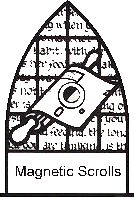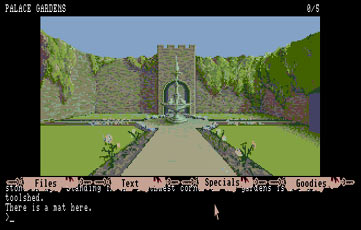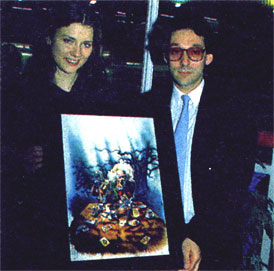News
News Archive
Downloads
Articles
Links
--------------------------
The Games
- The Pawn
- The Guild Of Thieves
- Jinxter
- Corruption
- Fish!
- Myth
- Wonderland
- The Magnetic Scrolls
Collection Vol. One
- The Legacy - Realm
Of Terror
--------------------------
Magnetic Interpreter
--------------------------
The Message Board
Guestbook
--------------------------
About The Website
Contact
|
| The
History Of Magnetic Scrolls |
| written
by Stephen Granade (used with kind permission) |
|
While Adventure
International, Topologika, and Level 9 all published text adventures
for the early 8-bit machines, Magnetic Scrolls came along later
and wrote text-and-graphics adventures for 16-bit computers
like the Atari ST, Amiga, and Sinclair QL. They also lasted
longer than the other companies -- their final game was published
in 1992.
The story
begins with Ken Gordon, Hugh Steers, and Rob Steggles, who were
classmates and friends. Ken and Hugh enjoyed playing with computers,
while Rob was more into Dungeons and Dragons. They all played
games like Zork and the Scott Adams adventures, however.
Ken eventually
met up with Anita Sinclair through some Apple user groups. Anita
was a fan of Infocom's adventures, and was interested in creating
some of her own. Anita and Ken formed Magnetic Scrolls early
in 1983 and bankrolled the company using Anita's savings.
|

The
Magnetic Scrolls Logo
|

Anita
Sinclair - co-founder and official face of Magnetic Scrolls
(source: Power Play magazine)
|
Ken and
Anita decided to write an adventure game for the Spectrum QL,
a new 16-bit machine based on the Motorola 68000 processor.
They hired Hugh Steers for his programming skills and asked
Rob Steggles to help them create a scenario. The four of them
brainstormed, coming up with a number of strange and odd ideas.
Eventually Rob took all of the ideas and wrote a story around
them. The game was called The Pawn because of the way the main
character was manipulated by events beyond his control.
The QL version
of The Pawn sold well enough that Magnetic Scrolls next did
a version for the Atari ST. The ST, like the Spectrum QL, was
based on the 68000 processor, but the ST had graphics capabilities
which the QL lacked. After they finished their ST port, Ken
and Anita took it to a publisher named Rainbird and applied
for a contract. Rainbird liked the game, but wanted to add graphics.
Magnetic Scrolls was understandably reluctant, but Rainbird
showed Ken and Anita the work of Geoff Quilley. Intrigued, they
had Geoff create two pictures for the game. They liked the result
enough that they went ahead and added pictures to the Atari
ST version of The Pawn, which Rainbird published in 1985, to
much success.
A side note:
the pictures in The Pawn and later Magnetic Scrolls games were
more like illustrations than exact pictures of a room or scene.
Geoff and other artists were given descriptions of scenes to
illustrate, but room descriptions were apt to change between
the time an artist was given them and the time the game shipped.
Magnetic Scrolls decided that having graphics which weren't
literal pictures of scenes was an interesting approach.
|
|
Following
the successful launch of the ST version of The Pawn, Magnetic
Scrolls began porting it to as many different computers as they
could. As was to become their practice, they wrote all the programs
they required, including a debugger, rather than use any commercial
products. In the meantime, they asked Rob to write another scenario
for them, a traditional fantasy. Rob quickly turned out the
plot and puzzles to The Guild of Thieves. It was eventually
published in 1987, with pictures by Geoff Quilley, and did very
well, winning the CGW Game of the Year award.
Magnetic
Scrolls had mixed success with their next two games, Jinxter
and Corruption. Corruption, written by Rob Steggles and programmed
by Hugh Steers, was a realistic thriller set in London. Its
plot revolved around insider trading and the stock market. It
garnered another Game of the Year award for Magnetic Scrolls.
Jinxter, which had come out the year before, sold as well as
Corruption but had been much more expensive to produce, as it
had involved a large team of writers and programmers.
Magnetic
Scrolls released two other games, Fish! and Myth, in the late
1980's, but attention was focused on an ambitious project named
Wonderland. The game was based on the works of Lewis Carroll,
and for it Ken, Anita, Hugh, and a team of programmers began
writing a new interpreter called Magnetic Windows for the Amiga,
Atari ST, and Microsoft Windows. Rather than use any off-the-shelf
products or routines they did what they had always done before:
write their own system.
|

The
famous picture that rocked the Interactive-Fiction-World back
in 1985 - the Palace Gardens from "The Pawn" by
Geoff Quilley (Amiga)
|
|

Anita
Sinclair and game designer David Bishop are presenting the "Wonderland"
artwork at the Consumer Trade Show in 1990 (source: Power Play
magazine)
|
It was a
costly decision. Magnetic Scrolls did finish Wonderland, and
Virgin Mastertronic published it in 1990, but it was the last
original game to come from Magnetic Scrolls. In 1991 Virgin
published a re-release of all of Magnetic Scrolls' Game of the
Year winners, The Guild of Thieves, Corruption, and Fish!, in
a collection entitled The Magnetic Scrolls Collection Volume
1.
The re-releases
were all updated to take advantage of the Magnetic Windows interpreter.
Before Magnetic Scrolls could finish converting their remaining
games to the Magnetic Windows interpreter, the company went
bankrupt in 1992 and was bought by Microprose, which did very
little with the rights it had bought.
Like the
Level 9 games, the Magnetic Scrolls games are no longer sold
and cannot be legally downloaded. There is some indication that
Magnetic Scrolls may one day reappear, however, as Ken Gordon
has registered the domain http://www.magneticscrolls.com,
though he has done nothing with it so far. Until then, Magnetic
Scrolls will be just a memory to those who loved their games.
|
Back
to Articles page
|


